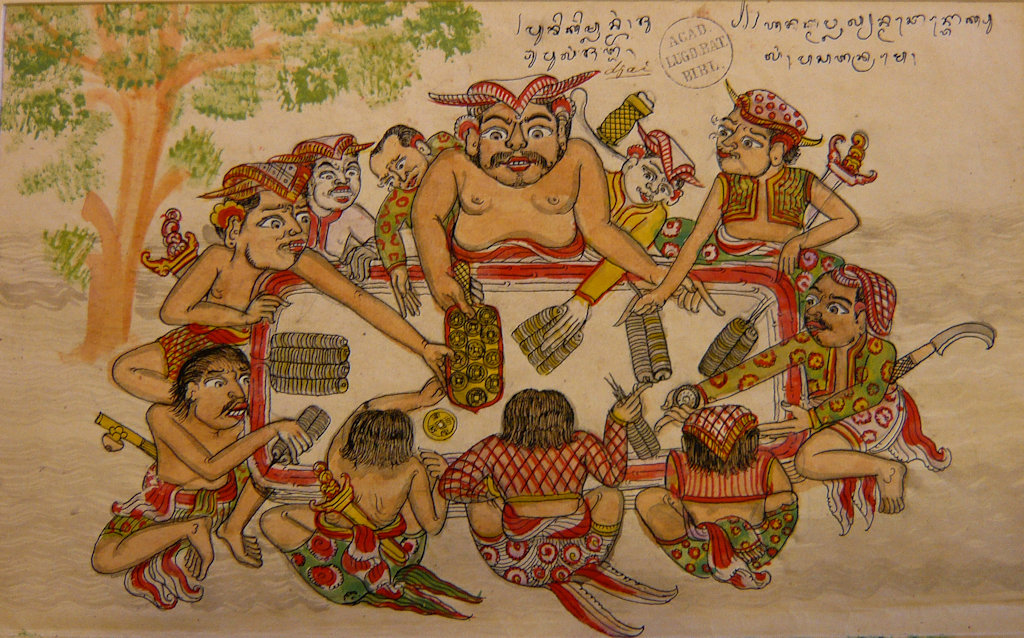KETOET GEDE, SINGARAJA, DRAWING OF MEN PLAYING A GAME WITH CHINESE COINS ON A BAT,
MACONTOK PULANG
LOr. 3390-54, top
Drawing on Dutch paper, watermark Amsterdam, countermark Van Gelder, 42 x 34.1 cm
A group of ten men sit around a large rectangular table. A tall man is depicted at the back in the centre. In his right hand he is holding a kind of bat on which twelve Chinese coins with a hole in the centre, kèpèng, are arranged in rows. A very large Chinese coin with a hole in the centre surrounded by four inscriptions is on the table to his right. The man points with his left hand at some coins lying on the table to the right. Six strings of coins, two of which are double, are either held by men or placed on the table. A man sitting on the right holds a large coin which has a ribbed rim and is provided with inscriptions in his right hand while pointing at another person holding a string of coins. All the men look fixedly at the man with the bat in the centre.
A text in Balinese script in ink at the top in the centre says: “puniki mlandang, juru pulang jai”, this man here is the leader, the man who puts down the coins. In Latin script Van der Tuuk has added: ‘djai”. According to his dictionary, Vol. IV: 343, “”jai” is a type of Chinese coin which is black, but one side of it has been painted red. Sixteen or eighteen of them are used in a game called “contok pulangan”.
At the top on the right is an inscription in Balinese script saying: “hanak maplalyan macontok pulang, pasangan ramé”, people playing with Chinese coins, many men bid,
The ten men, all ordinary Balinese according to their clothes, have bid.They put strings of coins and other coins on the table. The leader holds the bat. This is called “képang” in the dictionary (Vol. II: 495). The game consists in throwing the coins up (pulang). The number of coins which fall on the table and not on the bat correspond to a quarter of the compass. The money put on the table in this quarter is for the bidders.

It is not completely clear from the dictionary (IV: 343) which side of the jai should be painted red. The Chinese coins used in Bali date from the 18th and 19th century. They were made during the Manchu Dynasty. One side of the coins contains Chinese characters and the other side bears an inscription in Manchu script. Vol. II: 609, “trep”, mentions that the black side has numeral-liked script and Vol. II: 693, “tlèh”, that the ride side bears Chinese characters. It is probable that by numeral-like script the Manchu characters are meant. Van der Tuuk also gives in his dictionary some technical terms used during the game. If all the coins fall either on the black side or on the other side, so that there is no winner, this is called “sonar” (Vol. III: 22). If the coins fall with the black side up, this is “trep” (Vol. II: 609). If eight, twelve or four coins fall with the black side up, so that East wins, this is “tari” (vol. II: 585). If threee, seven or eleven coins fall with the black side up, so that South winds, this is “tiga datu” (Vol. II: 795). If ten, six or two coins fall with the black side up, so that West wins, this is “duga” (Vol. II: 527), and if one, five or nine coins fall with the black side up, so that North wins, this is “tlaga” (Vol. II: 714). The leader, mlandang, takes 10% of the profit (Vol. IV: 584). Under LOr. 18.841 (21) is kept a typewritten manuscript on games, based on data collected by Schwartz. It is, however, not known in which part of Bali he collected this information. Game No. 13 (LOr. 18.841(21): 23-24) describes the rules for “contok pulangan”. The game is played with sixteen coins which should be placed on the bat in rows of four, the red sided up. The rules of the game are described very elaborately, but they agree with our short description of the game.
